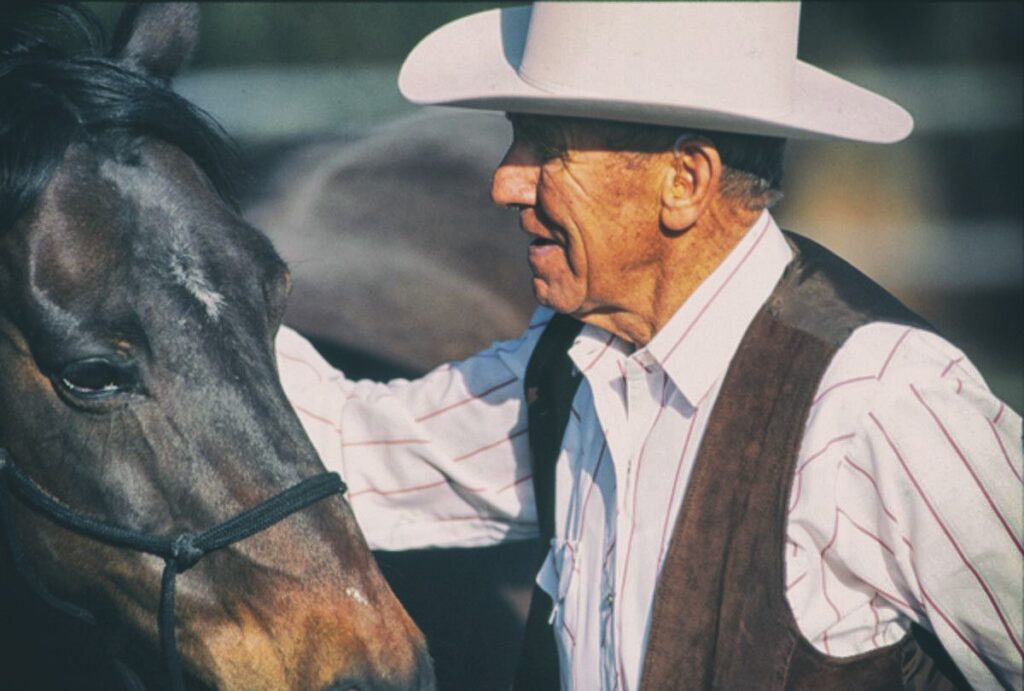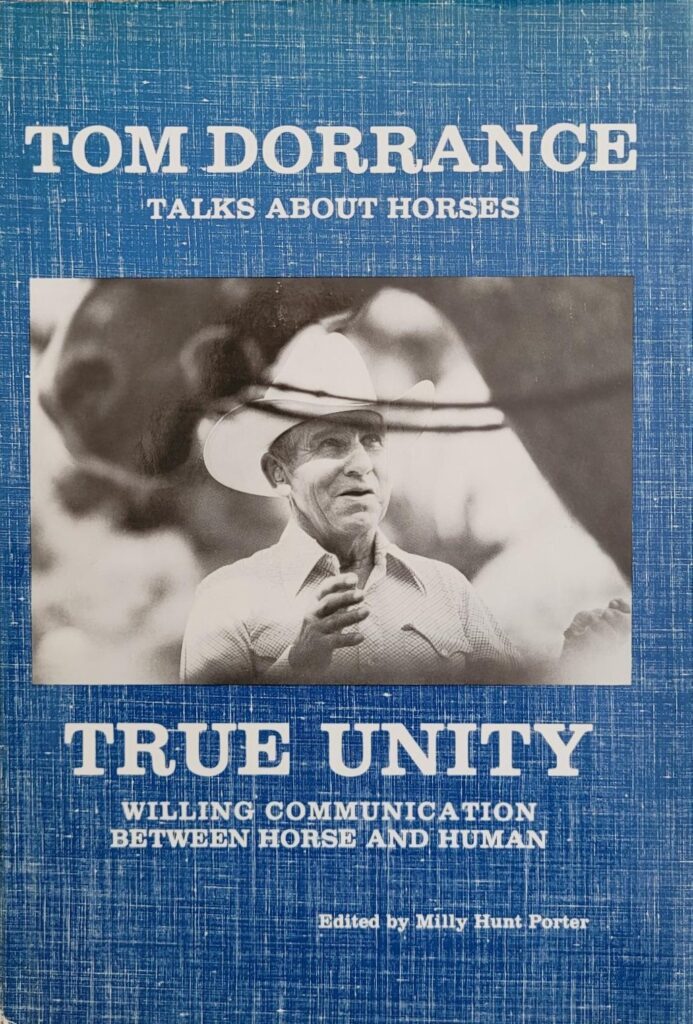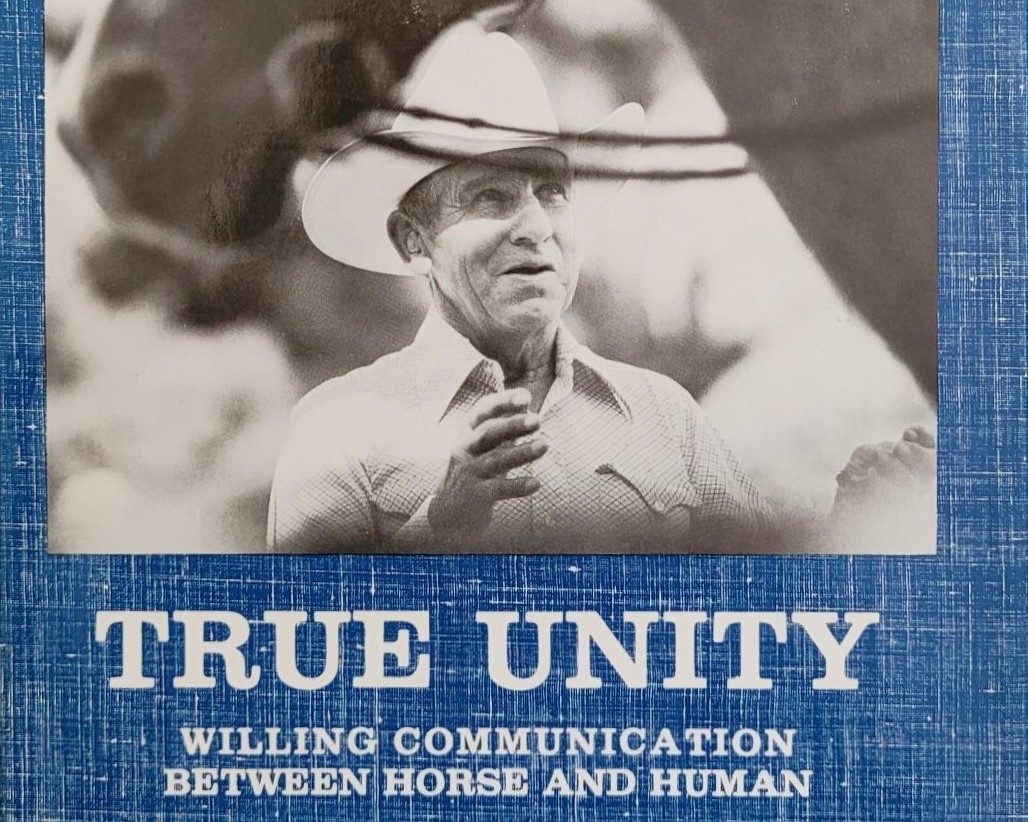That book is probably the most important concerning our matter: communication with horses. Unfortunately, I think that is also the most complicated to understand. Writing is good and vocabulary is common, but ideas developed in that text require a new way of thinking, a fresh mind about horses.
Table of Contents
The complete title of this book says it all: “True Unity, Willing Communication Between Horse and Human“.
Tom Dorrance is the most important reference when we deal with modern Natural Horsemanship in North America. He has launched this new wave of a more respectful horsemanship, although he probably never did it on purpose. This horseman was greatly skilled and reputed to be able to start a wild colt within a few hours, not by magic, simply by listening to the horse, and speaking to him in a clear, gentle, and comprehensive language.
The book contains different texts: some are written or said by Tom Dorrance _ they are the most interesting of course _, and some are written by students. Students are sometimes quite famous people such as Bill Dorrance, Martin Black, Bryan Neubert or Joe Wolters. Yet, I tend to be very critical with this kind of texts as people like to praise and idolize, and usually forget to be objective. Still, we can find some interesting information in these “Students’ feedbacks”.
True Unity is a very important resource as it contains lots of wisdom, all the natural horsemanship philosophy lays in these pages. That is also my main (only) criticism: you will not find any practical information, any exercise in the book. As in most books written by genius, it is full of treasures, but you have to dig hard to find them! In the present article, I try to dig up some of these treasures. I can not write about all of them as it would be too long and fastidious though.
There are three words, three concepts on which is based all Tom Dorrance’s approach to horses. The same concepts have been used to divide his texts in the book:
- Feel (“Feel the Whole Horse”)
- Timing (Responsive and Right On)
- Balance (Approach and Unity)
These ideas are the most valuable treasures, but also the most complicated to understand, and overall to apply in our daily horsemanship. We could actually pair them with qualities I talked about in other pages of this web site: Empathy, Patience, and Humility.
Feel
“The rider needs to recognize the horse’s need for self-preservation in Mind, Body, and, the third factor, Spirit.“
True Unity, Tom Dorrance
Mind and Body are quite easy to apprehend. Mind is the mental state of the horse, our role as horsemen and horsewomen is to make sure our equine partners are not stressed, are not afraid and live peacefully. Body is the physical state of the horse, we have to take care of their health, to make sure they are well fed, to protect them from any violence.
Defining Spirit is another matter. It is not easy to explain when we apply it to us, humans. So, it becomes quite a challenge when applied to another species: horses in our case. My understanding of Tom Dorrance’s explanations is that Spirit defines this spark of life that makes us and our horses unique individuals, that is combined to what he called togetherness _ that horse’s will to be with us, to get closer to humans in its own way.
Anyway, those three concepts have to be considered as one: Feel. The main quality we should develop as horsemen and horsewomen is empathy, our capacity to think as a horse, to figure out how our horse feels at the very moment we are with him, we spend time with him. Every time we ask something from our horse, we should feel it entirely: from his psychological state to his physical integrity to his will to be with us. We should start working with our horses from these observations, not from our to-do-list!

Timing
Timing is one word for several things. First, timing is a good moment in our life to grasp the concepts Tom Dorrance introduces to us. Indeed, some of us might not be able to understand some of his ideas, simply because we are in a period of our life where our mind is distracted by other issues, or because we have never taken the time to ask ourselves some essential questions about our approach to others, to new ideas, to animals, etc. Next, timing is a good moment in the horse’s life: “With horses you have to get their respect before you will get a response.
With other horses, you will try to get a response in order to get their respect.” Finally, timing is the harmony with your horse. This harmony is everywhere _ should be everywhere _ and the more we ride our horse, the more we get used to him, and the more synchronized we become: Rhythm of the feet, synchronization of the bodies on the move, anticipation of the horse, pressure release, etc. That is where patience becomes important!
“If you see that is going to happen, I’d say you withdraw your pressure before it happens, because if he is starting to do it, and the pressure is still there, it’s in the way of the horse.”
True Unity, Tom Dorrance
Balance
Balance covers two areas: The approach of the rider to the horse, and the physical abilities of the horse. We, as horsemen and horsewomen, have to consider how important is our behaviour in our horse’s education. Be too gentle and you will end up with a spoiled horse. Be too harsh and your horse will become spooky, and shy.
We should always weight carefully the consequences of our acts and decisions, as each of them is a part of the jigsaw puzzle: make sure it is placed correctly and gently, but make sure also that your horse keeps it in place, and respect your choice. That is where humility takes place as this requires your questioning yourself all the time. Do not be afraid to make a bad decision, your horse will forgive. More important, do not be afraid to analyze what you did, and to criticize your acts and decisions.
“If a horse doesn’t feel right on one side, […] try to figure out what is taking place on the side that seems to fit the best _ then try to help the horse learn to position the other side.”
True Unity, Tom Dorrance
Our horses, most of the time, have difficulties to be naturally as good on one side as on the other. As we can be either left-handed or right-handed, horses are “left-sided” or “right-sided”. Hopefully, horses learn faster than we do, and we can teach them to be good and at ease on both sides. Of course, it is not necessary to ride a horse, but it feels a lot better and it helps the horse.
Tom Dorrance is THE natural horsemanship reference
Well, I would like to conclude this article by quoting the title of the last chapter written by Tom Dorrance in this book: “Learning to Do Less to Get More.” Sometimes, we tend to do too much to obtain the expected result. We so much want something to happen that we increase pressure, become hard instead of firm, and obtain a result opposite to what we expect… Food for thought.

